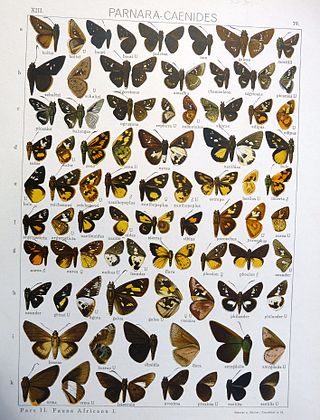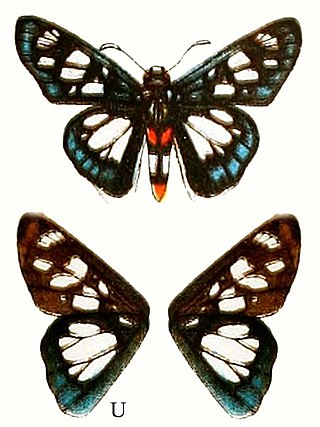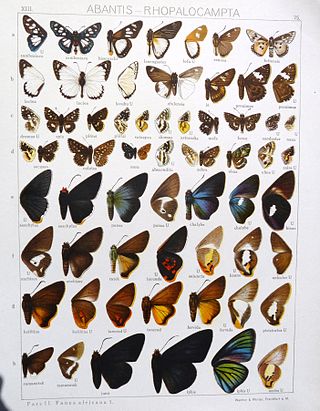
Skippers are a group of butterflies placed in the family Hesperiidae within the order Lepidoptera. They were previously placed in a separate superfamily, Hesperioidea; however, the most recent taxonomy places the family in the superfamily Papilionoidea, the butterflies. They are named for their quick, darting flight habits. Most have their antenna tips modified into narrow, hook-like projections. Moreover, skippers mostly have an absence of wing-coupling structure available in most moths. More than 3500 species of skippers are recognized, and they occur worldwide, but with the greatest diversity in the Neotropical regions of Central and South America.

Gegenes nostrodamus, commonly known as the dingy swift, light pygmy skipper, Mediterranean skipper or veloz de las rieras, is a butterfly belonging to the family Hesperiidae. It is found from the Mediterranean Sea, through Anatolia to Turkestan and India.

Paracleros is a genus of skippers in the family Hesperiidae. They are generally found in the continent of Africa.

Platylesches picanini, the banded hopper, is a butterfly of the family Hesperiidae. It is found in Senegal, Gambia, Guinea, Sierra Leone, Liberia, Ivory Coast, Ghana, Nigeria, Cameroon, the Democratic Republic of the Congo, Uganda, south-western Kenya, Tanzania, Malawi, northern Zambia, Mozambique, Zimbabwe and South Africa. The habitat consists of forests, riparian vegetation along river courses, woodland, dry forests and Guinea savanna.

The Erionotini are a tribe of skipper butterflies in the subfamily Hesperiinae.
Ceratricula is a genus of butterflies in the family Hesperiidae. It is monotypic, being represented by the species Ceratricula semilutea, commonly known as the tufted forest sylph which is found in Guinea, Sierra Leone, Liberia, Ivory Coast, Ghana, Nigeria, Cameroon, Gabon, the Central African Republic, the Democratic Republic of the Congo, Uganda, north-western Tanzania and north-western Zambia. The habitat consists of forests.
Paracleros maesseni, Maessen's dusky dart, is a butterfly in the family Hesperiidae. It is found in Ghana and Nigeria.

Paracleros placidus, the western dusky dart, is a butterfly in the family Hesperiidae. It is found in Ivory Coast and Ghana. The habitat consists of grassy, shady areas in forests.
Paracleros sangoanus is a butterfly in the family Hesperiidae. It is found in Uganda and north-western Tanzania. Its habitat consists of forests. It was described by English entomologist Robert Herbert Carcassonin, who specialised in butterflies.
Paracleros staudei is a butterfly in the family Hesperiidae. It is found in western Kenya. The habitat consists of forests.

Paracleros substrigata, Berger's dusky dart, is a butterfly in the family Hesperiidae. It is found in Ivory Coast, Ghana, Nigeria, Cameroon, Gabon, the Central African Republic, the Democratic Republic of the Congo and western Tanzania. The habitat consists of forests.
Paronymus budonga is a butterfly in the family Hesperiidae. It is found in western Uganda and north-western Tanzania. The habitat consists of forests.

Paronymus nevea, the scarce largest dart, is a butterfly in the family Hesperiidae. The species was first described by Hamilton Herbert Druce in 1910. It is found in Guinea, Ghana, Nigeria, Cameroon, the Central African Republic, the eastern part of the Democratic Republic of the Congo and north-western Zambia. The habitat consists of primary forests.

Paronymus xanthias, the yellow largest dart, is a butterfly in the family Hesperiidae. It is found in Guinea, Sierra Leone, Ivory Coast, Ghana, Nigeria, Cameroon, Gabon, the Republic of the Congo, the Central African Republic, the Democratic Republic of the Congo, Uganda, Tanzania and Zambia. The habitat consists of forests.

Celaenorrhinus proxima, commonly known as the common black sprite, is a species of butterfly in the family Hesperiidae. It is found in Guinea, Sierra Leone, Liberia, Ivory Coast, Ghana, Togo, Nigeria, Cameroon, Democratic Republic of the Congo, Sudan, Uganda, Kenya and Tanzania. The habitat consists of forests and heavy woodland.

Eagris lucetia is a species of butterfly in the family Hesperiidae. It is found in Cameroon, the Republic of Congo, the Democratic Republic of Congo, southern Sudan, Uganda, western Kenya, western Tanzania, Angola and northern Zambia. The habitat consists of forests and forest margins.

Calleagris lacteus, the milky scarce flat, is a butterfly in the family Hesperiidae. It is found in Guinea, Sierra Leone, Liberia, Ivory Coast, Ghana, Nigeria, Cameroon, the Republic of the Congo, the Central African Republic, the Democratic Republic of the Congo, Uganda, Tanzania and Zambia. The habitat consists of wetter forests.

Sarangesa brigida, commonly known as Brigid's elfin, is a species of butterfly in the family Hesperiidae. It is found in Guinea-Bissau, Guinea, Sierra Leone, Liberia, Ivory Coast, Ghana, Nigeria, Cameroon, Gabon, the Central African Republic, the Democratic Republic of the Congo, Sudan, Uganda, Kenya, Tanzania and Zambia. The habitat consists of forest edges and clearings.

Abantis zambesiaca, the Zambezi paradise skipper, is a butterfly in the family Hesperiidae. It is found in western and southern Tanzania, the Democratic Republic of Congo (Shaba), Zambia, Malawi, Namibia (Caprivi), Mozambique and Zimbabwe. The habitat consists of savanna and Brachystegia woodland.

Coeliades hanno, the three pip policeman or western policeman, is a butterfly in the family Hesperiidae. It is found in Senegal, Guinea, Sierra Leone, Liberia, Ivory Coast, Ghana, Togo, Nigeria, Cameroon, Equatorial Guinea (Bioko), São Tomé, Gabon, the Republic of the Congo, the Central African Republic, Angola, the Democratic Republic of the Congo, Uganda, western Kenya, western Tanzania and Zambia. The habitat consists of forests and dense savanna.











